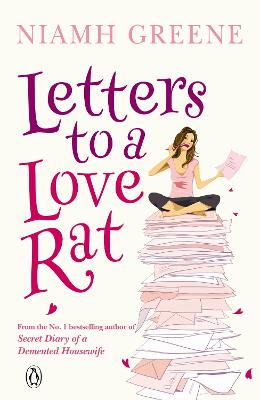Reviewed by Leah on
Letters To A Love Rat is Irish author Niamh Green’s third book after her ‘demented housewife’ double. I haven’t managed to get my hands on her ‘demented housewife’ double but when I saw this in the book swop I picked it up and liked the sound of it. It sounded like an interesting and quirky read and I really liked the cover so I decided to go ahead and get it. The book is just over 300 pages long and only took me 2/3 hours to read the entire thing.
The book starts with a prologue featuring letters to Charlie from girlfriends from years gone by before introducing us to his new wife Molly. Within the first chapter we learn about how Molly and Charlie met before ending up married and we’re with Molly when she picks up Charlie’s note in which he dumps her. We are then introduced to Julie’s Blog and we find out she’s having an affair with her boss, Mr X. Her blog posts are more like a timeline of a particular time in her day rather than one long post and I find that works very well. We also get to read people’s comments on her blog post. Finally we are introduced to Eve. Although introduced probably isn’t the right word because all we learn of Eve is through the letters she writes to Charlie. So only one portion of the three perspectives are written like an actual book and I thought that was a very interesting way to write a book and I enjoyed switching from proper story to blog posts to letters.
While I enjoyed the different writing styles and loved Julie’s blog posts, I found that I wasn’t really interested in Molly’s part of the story and less so to Eve’s part of the story. Julie’s blog posts were incredibly unique and were undoubtedly my favourite part of the entire book. I found myself rushing through Molly’s parts and merely skimming Eve’s letters just so I could get back to Julie. That obviously hampered by enjoyment of the whole book because I wasn’t really bothered about 2/3’s of the book and I felt they were superfluous in all honesty. I could easily have read 300+ pages of just Julie’s blog posts.
None of the characters appeared to have any kind of backbone when it came to men. Molly should have been indignant and angry to be dumped but she just seemed incredibly sappy and irritating. I kept hoping she would go to Charlie’s office to demand answers and she just never did. She acted as if he had fallen off the face of the Earth, never to be seen again. I truly couldn’t stand Eve. She dumped Charlie two years ago but a wedding picture sends her into such a hissy fit I was surprised she wasn’t put into a white padded room. Her drippiness and inability to move on drove me insane and I just wanted to take her by the shoulders and give her a good shake. Julie was by far my favourite character but I couldn’t stand her either. She had no shame about being in an affair (she uses the excuse that it’s not *her* cheating on anyone – note to Julie: that’s the worst excuse ever to try and justify cheating) and the fact is that even when Charlie left Molly for her she didn’t even seem particularly bothered. She only seemed to care for herself but she was the most honest of all three women; she knew she didn’t really want a relationship with Charlie and only really fell into it because of the circumstances. She was also the most amusing of the three women and she made the book for me.
The three different writing styles should have made the book interesting and unputdownable. Instead it all kind of fell flat on it’s face. From the reviews I’ve read of Niamh’s previous two books they seemed to be quite amusing but there’s was no humour at all in Letters To A Love Rat. Julie was mildly amusing at times but it was hardly a laugh-out-loud read. When I started reading Letters To A Love Rat this morning I didn’t know what to expect, I finished it feeling as if I should have been given more. It certainly had a lot of potential but for me 2/3’s of the book just didn’t work for me and I found them rather boring. I’d recommend the book but only so you can read Julie’s blog posts! They’re enjoyable – particularly the comments from others on her posts. That’s the only part worth reading.
Reading updates
- Started reading
- 1 January, 2010: Finished reading
- 1 January, 2010: Reviewed
